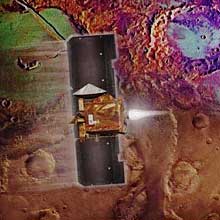
An artist's depiction of the 2001 Mars Odyssey spacecraft firing its engine to brake upon reaching Mars. The brightly colored landscape represents the surface-composition mapping that the craft will return — a major mission objective.
Courtesy NASA/JPL.
Mars Odyssey, the latest orbiter to start mapping the red planet, is back to full working order. Its cameras have always worked fine, but last August controllers lost communication with Odyssey's Mars Radiation Environment Experiment (MARIE) while the craft was still en route to Mars. The broken component — designed to measure the radiation danger that future travelers to Mars might encounter — was largely ignored until the craft reached its low mapping orbit in February and engineers could take the time to figure out what went wrong.
They soon diagnosed the problem as a memory error in the instrument's onboard software. They were able to fix it and reestablished contact with MARIE on March 7th, and yesterday the instrument resumed its work. MARIE will now "set out to calculate what the [radiation] dose rate would be [for a human] on the surface of Mars," says MARIE team member Timothy Cleghorn (NASA/Johnson Space Center).
MARIE did take data for 78 days while in flight between Earth and Mars, and those results, presented this week at the Lunar and Planetary Science conference in Houston, Texas, are of serious concern to future space travelers. Astronauts orbiting Earth are partially protected from harmful charged-particle radiation by our planet's magnetosphere. But space travelers destined for Mars will face the harsh, hazardous radiation of interplanetary space with no such protection for months on end.
The main culprit is the Sun, which spews high-energy particles throughout the solar system. Solar flares can boost the particle flux drastically and unpredictably. Other high-energy cosmic-ray particles arrive from beyond the solar system. Some of these tiny, high-energy bullets are larger and more worrisome than others. "Heavy ions are the dangerous ones because they cause double breaks in DNA [smashing apart both sides of the double-helix molecule], and the DNA may not repair itself correctly," says Cleghorn. Damaged DNA can cause cellular mutations and cancer.
The early MARIE results indicate that an astronaut en route to Mars would absorb twice the average daily dose of radiation that inhabitants of the International Space Station currently receive. Heavy-ion dosages would be triple those at the ISS. Since radiation damage is cumulative, the risks to interplanetary astronauts could be substantial.
"It's a real problem for getting humans out there," adds Cleghorn. "It's not an insurmountable problem, but it will be a challenge to deal with."
 0
0
Comments
You must be logged in to post a comment.